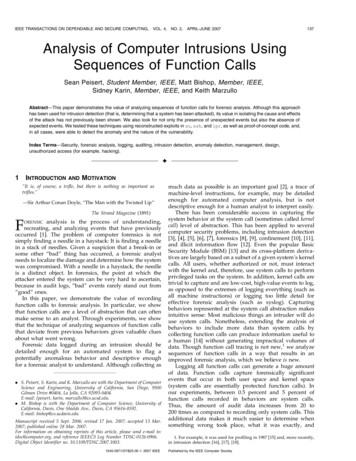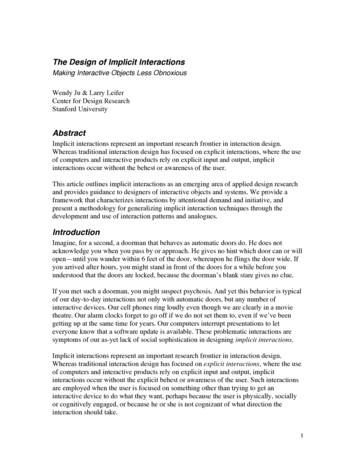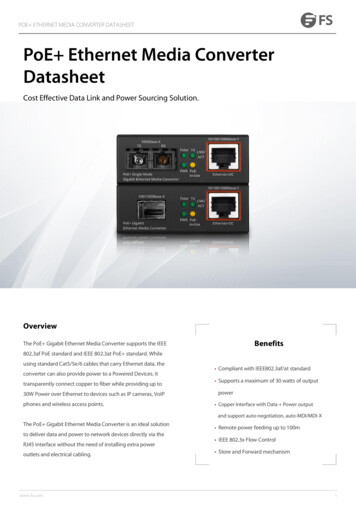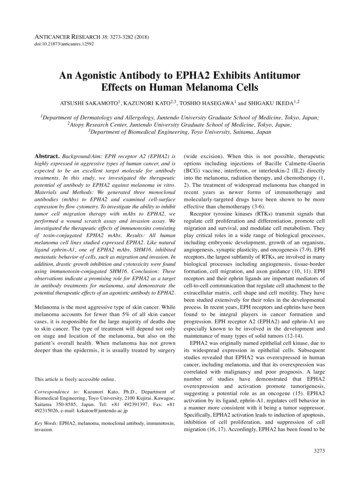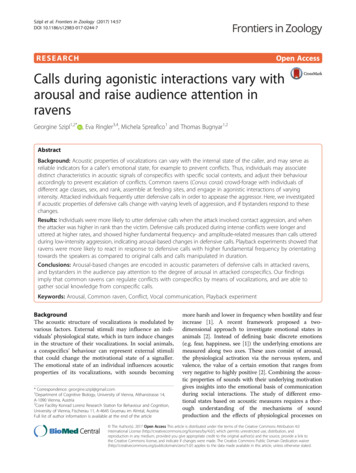
Transcription
Szipl et al. Frontiers in Zoology (2017) 14:57DOI 10.1186/s12983-017-0244-7RESEARCHOpen AccessCalls during agonistic interactions vary witharousal and raise audience attention inravensGeorgine Szipl1,2* , Eva Ringler3,4, Michela Spreafico1 and Thomas Bugnyar1,2AbstractBackground: Acoustic properties of vocalizations can vary with the internal state of the caller, and may serve asreliable indicators for a caller’s emotional state, for example to prevent conflicts. Thus, individuals may associatedistinct characteristics in acoustic signals of conspecifics with specific social contexts, and adjust their behaviouraccordingly to prevent escalation of conflicts. Common ravens (Corvus corax) crowd-forage with individuals ofdifferent age classes, sex, and rank, assemble at feeding sites, and engage in agonistic interactions of varyingintensity. Attacked individuals frequently utter defensive calls in order to appease the aggressor. Here, we investigatedif acoustic properties of defensive calls change with varying levels of aggression, and if bystanders respond to thesechanges.Results: Individuals were more likely to utter defensive calls when the attack involved contact aggression, and whenthe attacker was higher in rank than the victim. Defensive calls produced during intense conflicts were longer anduttered at higher rates, and showed higher fundamental frequency- and amplitude-related measures than calls utteredduring low-intensity aggression, indicating arousal-based changes in defensive calls. Playback experiments showed thatravens were more likely to react in response to defensive calls with higher fundamental frequency by orientatingtowards the speakers as compared to original calls and calls manipulated in duration.Conclusions: Arousal-based changes are encoded in acoustic parameters of defensive calls in attacked ravens,and bystanders in the audience pay attention to the degree of arousal in attacked conspecifics. Our findingsimply that common ravens can regulate conflicts with conspecifics by means of vocalizations, and are able togather social knowledge from conspecific calls.Keywords: Arousal, Common raven, Conflict, Vocal communication, Playback experimentBackgroundThe acoustic structure of vocalizations is modulated byvarious factors. External stimuli may influence an individuals’ physiological state, which in turn induce changesin the structure of their vocalizations. In social animals,a conspecifics’ behaviour can represent external stimulithat could change the motivational state of a signaller.The emotional state of an individual influences acousticproperties of its vocalizations, with sounds becoming* Correspondence: georgine.szipl@gmail.com1Department of Cognitive Biology, University of Vienna, Althanstrasse 14,A-1090 Vienna, Austria2Core Facility Konrad Lorenz Research Station for Behaviour and Cognition,University of Vienna, Fischerau 11, A-4645 Gruenau im Almtal, AustriaFull list of author information is available at the end of the articlemore harsh and lower in frequency when hostility and fearincrease [1]. A recent framework proposed a twodimensional approach to investigate emotional states inanimals [2]. Instead of defining basic discrete emotions(e.g. fear, happiness, see [1]) the underlying emotions aremeasured along two axes. These axes consist of arousal,the physiological activation via the nervous system, andvalence, the value of a certain emotion that ranges fromvery negative to highly positive [2]. Combining the acoustic properties of sounds with their underlying motivationgives insights into the emotional basis of communicationduring social interactions. The study of different emotional states based on acoustic measures requires a thorough understanding of the mechanisms of soundproduction and the effects of physiological processes on The Author(s). 2017 Open Access This article is distributed under the terms of the Creative Commons Attribution 4.0International License (http://creativecommons.org/licenses/by/4.0/), which permits unrestricted use, distribution, andreproduction in any medium, provided you give appropriate credit to the original author(s) and the source, provide a link tothe Creative Commons license, and indicate if changes were made. The Creative Commons Public Domain Dedication o/1.0/) applies to the data made available in this article, unless otherwise stated.
Szipl et al. Frontiers in Zoology (2017) 14:57vocal production [3]. Vocalizations in humans are produced by the vibrating tissue (the source), and thenshaped by the vocal tract (the filter) [4]. Although thisconcept was developed on human speech, it was successfully generalized to mammal vocal production [5, 6] andperception [7–9].Recent studies suggest that although the vocal apparatusof mammals differs morphologically from the soundproducing organ of birds, the concept of the source-filtertheory can still be applied to avian species both from aproduction [10–18] and a perception side [19, 20]. Hence,source- and filter-related acoustic features known to varywith arousal in mammals (e.g. fundamental and formantfrequencies, amplitude, call duration; [21–23]) shouldcause comparable changes in acoustic parameters also inbirds [18]. These acoustic parameters may thus serve asreliable indicators of a caller’s emotional state in general,and may help to manage social interactions with conspecifics and prevent escalation of conflicts. As communication usually occurs in a network of several animals insignalling and receiving range of each other [24], the emotional state of a caller may influence the behaviour ofseveral individuals, addressees in direct interactions andbystanders alike. Consequently, studies should also takeinto account whether bystanders respond to arousal-baseddifferences in acoustic signals, and thus are capable ofinferring the emotional state of the caller.Common ravens are opportunistic scavengers andgather at large ephemeral food sources such as carcasses[25], where they engage in agonistic interactions of varying intensity with conspecifics [26]. The intensity of anattack can be divided into attacks with and withoutphysical contact: during fights and forced retreats, theaggressor attacks the victim with its beaks and claws,while the victim either fights back, or retreats [27]. During approach-retreat interactions (hereafter ‘retreats’)and submissive displays, the victim is displaced withoutphysical contact. Yet, during submissive displays the aggressor shows self-assertive displays, with erectedfeathers above the eyes (‘feather-ears’) and the flanks,and the victim signals subordination through a retractedneck and a depressed plumage [27]. Independent of thelevel of aggression, the victims may utter defensive calls.Ravens were shown to establish a dominance hierarchythat is structured by age, sex, and bonding status: adultbirds usually outrank younger ones, males outrankfemales, and birds with bonding partners outrank singletons [28].Ravens have a large vocal repertoire [29, 30], includingspecies-typical and individually learned calls. Among theformer, many call types are well-studied with respect tocall production and function (e.g. food-associated calls:[31–34] and territorial calls: [35, 36]), while comparablylittle is known about defensive calls. Defensive calls havePage 2 of 13been described as highly variable in duration, and areuttered as single calls or sequences of several calls whenretreating from dominant conspecifics [37, 38]. As onlyvictims call when retreating from aggressors, it seemsthat defensive calls function to signal distress and subordination, or ‘appeasement’ [39]. The experienced emotions during attacks are almost certainly negative for thevictims; however, the level of arousal may vary with theintensity of the aggression and the perceived threat, andtherefore should be reflected in the acoustic structure ofdefensive calls. In mammals, the most prominentchanges in vocalizations relate to call duration, call rate,amplitude, and fundamental frequency, with callsbecoming longer, higher in rate, louder and harsher withincreasing arousal [23].We here investigated defensive calls of individuallymarked free-ranging ravens in the Austrian Alps duringagonistic encounters of varying intensity in the contextof foraging. We first identified agonistic interactions andanalyzed whether in addition to the intensity of theattack the opponents’ rank and relatedness influencedcalling occurrences. We expected that the propensity tocall and the number of calls emitted would vary with thelevel of aggression, i.e. calling would be more likely andmore calls would be uttered when the conflict was moresevere. In addition, the propensity to call and the number of calls uttered may vary inversely with fightingability, whereupon we would expect calling propensityand the number of calls to be higher in low-ranking individuals. Finally, we expected conflicts to occur predominantly between unrelated individuals, as kin wereshown to support each other during agonistic interactions [40]. We then analyzed the acoustic structure ofdefensive calls with special emphasis on acoustic parameters found to relate to arousal in mammals. We expected to find variation in accordance with those shownin mammals [23], e.g. longer and less tonal defensivecalls with increasing attack intensity and opponents’rank disparity.Defensive calls raise the attention of bystanders [39, 41].Victims of aggression were shown to receive social supportfrom bystanders that are lower in rank than themselves, thatsupported them in previous conflicts, and from kin as wellas bonding partners [28, 40]. It remains unknown whethercalling increases the probability of receiving support, andwhich acoustic features of defensive calls bystanders pay attention to. Thus, we selected two parameters that showedsignificant variation in victims’ defensive calls according tothe intensity of the attack, and manipulated these parameters experimentally. Using playback experiments, we testedreceivers’ abilities to discriminate between natural andmanipulated defensive calls. We hypothesized that higherproportions of bystanders would look towards the speakerwhen playing back calls that simulated increased arousal.
Szipl et al. Frontiers in Zoology (2017) 14:57MethodsData collectionDyadic agonistic interactions were observed ad libitum[42] from August 2010 to July 2012 at the enclosures ofwild boars, bears and wolves during morning feedings(0700–0900 a.m.) at the Cumberland Gamepark in Grünauim Almtal, Upper Austria (47 51′ N, 13 57′ O). The gamepark is built into a naturalistic landscape along the riverAlm. Free-ranging ravens gather during morning feedingsto snatch food from zoo animals, and are well habituatedto the presence of human observers at those enclosures.In the course of an ongoing monitoring project, ravenshave been trapped and marked individually usingcoloured leg rings and metal rings from the Germanringing station. The age class (juvenile, subadult, andadult) was determined by the coloration of the innerbeak, which is pink in juveniles below 1 year, pinkishwith dark speckles in 2 to 3 year olds, and turns completely black in adult birds aged older than 3 years [43].At the start of the study, 130 ravens had been markedalready. Another 74 ravens were marked in the course ofthe study, totalling 204 marked ravens. As non-breederravens are vagrant, the number and identity of birdspresent at the feedings varied daily and seasonally. Anaverage of 22.97 8.5 (SD) marked ravens were presentduring daily feedings in the study period (N 516 days).At the onset of each feeding, observers were positionednext to the outer fence of the enclosures and deliveredthe food to the zoo animals, which prompted the ravensto land inside the enclosure and start foraging. Data wasrecorded using binoculars and voice recorders. Inaddition, all foraging ravens were video-taped using adigital camera (Canon HF-11 HD camcorder). From thevideos, we coded the identity of both opponents andwhether the victim produced defensive calls for eachdyadic agonistic interaction between marked individuals.In addition, we coded the occurrence of an interventionby a third party, and whether the third party supportedthe victim, or the aggressor. From August 2011 to July2012, sound recordings were conducted in addition tobehavioural observations using a Sennheiser ME67 directional microphone (frequency response: 40–20,000 Hz) ona K6 Module connected to a Marantz recording device(Marantz PMD-670). Recordings were conducted at distances of 3–10 m with a sampling rate of 48 kHz and a16-bit amplitude resolution.Page 3 of 13and also in our data, adult birds outranked subadultsand juveniles (Kruskal-Wallis test: H 23.777, df 2,p 0.001), and males had a higher rank than females(Mann-Whitney U test: U 391.0, p 0.001). Thus,only rank differences (rank aggressor - rank receiver)were used in subsequent analyses.Factors influencing calling propensity and the number ofcalls utteredGeneralized Linear Mixed Models (GLMMs) were calculated on 865 agonistic interactions involving 83 markedindividuals (468 dyads) using the lme4 package [46] in R[47]. Calling (yes/no) was used as binomial response variable with a logit link function. The full model included thefactors level of aggression (fight, forced retreat, retreat,and submission), rank difference of opponents, and kinship of opponents based on DNA analysis (full-sibling/parent-offspring, half-sibling, unrelated; detailed descriptions are provided in the Additional file 1). As randomfactor the identities of the opponents was entered toaccount for repeated interactions between opponents. Toanalyze the number of calls uttered during an agonisticinteraction bout, a total of 135 bouts were analyzed with aGLMM using a Poisson distribution and a log link function. The identities of the opponents were used as a random factor. Level of aggression, rank difference ofopponents, kinship of opponents, two-way interactionsbetween level of aggression and rank difference and levelof aggression and kinship were used as fixed factors. Variance inflation factors were calculated beforehand for allfixed factors in the model to ensure that no collinearparameters were entered in the models [48]. To rank themodels, the difference in AICc (ΔAICc) was calculated bysubtracting the lowest AICc from all others. As measuresof strength of evidence for each model, relative likelihood(exp ( 0.5/ΔAICc)) and Akaike weight (relative likelihood/sum of all relative likelihoods) were computed [49].The models with the highest support were selected basedon ΔAICc values (ΔAICc 2). As several models had highsupport, models were averaged using the MuMIn package[50] in R [47]. Post hoc pairwise comparisons were conducted using the multcomp package [51] in R [47], whichaccounted for multiple comparisons. The averaged modelsare shown in Table 1, the full model selection is presentedin the Additional file 1: Table S1.Sound analysisDominance hierarchyDominance indices were calculated on 942 agonistic interactions using SOCPROG 2.6 with MATLAB R2015a [44].Modified David’s scores that account for unbalanced interaction rates [45] were extracted of each individual andnormalized to obtain scores ranging from 0 to 1. Age classand sex are closely linked to dominance in ravens [28],A total of 377 defensive calls of 30 individuals were analyzed with a custom-built script in PRAAT [52]. Thedetailed routine is provided in the Additional file 2. Parameters measured were call duration (s), harmonicity(dB), amplitude measures: mean (dB), minimum (dB),relative time of minimum (%), maximum (dB), relativetime of maximum (%), amplitude variation over time
Szipl et al. Frontiers in Zoology (2017) 14:57Page 4 of 13Table 1 Results of averaged models (all models with AICc value 2) on the propensity to call, and the number of call perinteraction bout, with estimated means (EM), adjusted standard errors (SE), z values, and lower and upper confidence intervals (CI)CoefficientsLevel 5823.220.733.01Calling propensityInterceptLevel of aggressionforced retreat 1.0520.5781.82 2.180.08retreata 4.3700.6876.36 5.72 3.02submissiona 1.6900.7082.39 3.08 0.30retreatb 3.3180.3449.66 3.99 2.65asubmission 0.6390.4091.56 1.440.16submissionc2.6800.4685.73 3.10 1.900.4820.4511.07 0.401.37bRank differenceNumber of calls/boutInterceptLevel of aggression2.1430.3146.831.532.76forced retreata 1.7020.3285.19 2.35 1.06aretreat 1.6980.4523.75 2.58 0.81submissiona 0.8770.4042.17 1.67 0.09retreat0.0040.3390.01 952.080.051.59 0.1590.3720.43 0.890.57bsubmissionRank differenceSet as reference:afightbforced retreatcretreat(dB/s); measures of the fundamental frequency (fo):mean (Hz), minimum (Hz), relative time of minimum(%), maximum (Hz), relative time of maximum (%),range (Hz), start (Hz), end (Hz), and sum of variation(sum of all fo changes); jitter; inflex (number of fochanges/s); and tonality (relative duration of tonal parts).To reduce the amount of acoustic variables, a PrincipleComponent Analysis (PCA) was conducted. Call durationloaded on a single component in the PCA (cp. Table S2 inthe Additional file 1) and did not group with other acoustic measures, and thus was excluded from the analysis.PCA was recalculated without call duration, and threePrinciple Components (PCs) with eigenvalues greater than1.0 were extracted which explained 90.27% of the totalvariance (Table 2). The Kaiser-Meyer-Olkin measure ofsampling adequacy was 0.708, indicating that the data wassuitable for PCA. The first extracted PC included fo-related variables (mean, minimum, maximum, start and endfo) and explained 51.62% of the variance (hereafter termedfo component). PC2 was comprised of amplitude-relatedvariables (mean, minimum, maximum) and explained27.59% of the variance (hereafter termed amplitude component). PC3 grouped the variables tonality and jitter,adding 12.19% to the total variance (hereafter termed jitterand tonality component). Regression scores of the threePCs were extracted. Call duration was analyzed separatelyusing original measured values in seconds instead of regression scores.Linear Mixed Models (LMMs) were calculated forthe regression scores of each PC and call durationwith a gaussian distribution and an identity link function with the lme4 package [46] in R [47]. As opponents were sampled multiple times, and as victimsuttered several calls per interaction bout, a randomfactor was entered which nested consecutive calls ofeach interaction bout within the aggressor-victimdyad. The full models included the fixed factors levelof aggression, rank difference of opponents, and kinship of opponents. In addition, two-way interactionsbetween level of aggression and rank difference andlevel of aggression and kinship were added to the fullmodel. All fixed factors in the model were tested formulticollinearity [48]. All models were ranked usingrelative likelihood and Akaike weights as describedabove, and the models with the highest support areshown in Table 3. Post hoc pairwise comparisonswere done using the multcomp package [51] in R[47] to account for multiple comparisons. The fullmodel selection table is presented in Table S3 in theAdditional file 1.
Szipl et al. Frontiers in Zoology (2017) 14:57Page 5 of 13Table 2 Component matrix with loadings of the PCAAcoustic VariablePrincipal Components123Mean fo (Hz)0.970.180.08Minimum fo (Hz)0.970.09 0.01Maximum fo (Hz)0.940.200.07End fo (Hz)0.930.10 0.01Start fo (Hz)0.930.08 0.02Mean amplitude (dB)0.170.970.15Maximum amplitude (dB)0.190.960.13Minimum amplitude (dB)0.100.960.17Jitter 0.16 0.08 0.90Tonality 0.140.290.84% of variance explained51.6227.5912.19Eigenvalue5.162.761.22The dimension of the acoustic variables measured from defensive calls (N 377)were reduced to three PCs. Loading higher than 0.5 are highlighted in boldIndividual discrimination was tested with a permutateddiscriminant function analysis (pDFA; [53]) in R [47]. Acrossed pDFA with 1000 permutations was calculated ona fully balanced set of 115 calls of 23 individuals (5 callsper individual) using the three PC scores and callduration.Playback experiment and analysisEight defensive calls of four male and four female adultravens with known identity were selected with littlebackground noise and no overlapping calls of otherbirds. All calls were similar in duration (mean SD:0.187 s 0.024) and mean fo (mean SD: 447.89 Hz 17.33). Calls were adjusted to the lowest sound pressurelevel using Sound Booth for Mac to assure that all callshad the same sound pressure level. Duration and fo manipulations were conducted in PRAAT [52]. Each call wasshortened and lengthened by 50%, and fo was shifted upand down by 100 Hz. The routine used in PRAAT is described in the Additional file 1. We designed a playbackexperiment to test responses, defined as head turns towards the speaker, of free-ranging ravens to defensivecalls manipulated in frequency and duration. We conducted 8 sessions to test responses to duration manipulations, and 8 sessions to test responses to frequencymanipulations. In each session, we played three calls, theoriginal, unmanipulated defensive call, and two calls either manipulated in duration (shorter and longer) or info (shifted up and down by 100 Hz) in randomizedorder. Sessions testing duration and fo were alternated.The minimum interval between two played back calls ina session was 2 min, and the minimum interval betweentwo sessions was 1 week. Playbacks were conducted during morning feedings. Thirty minutes prior to the feeding, a battery-powered loudspeaker (Roadboy 65, LDSystems, frequency response: 80–15,000 Hz) was placedapproximately 3 m from the fence of the wild boar enclosure, and concealed with a camouflage net. Whenfeeding started, the food was provided to the wild boars,causing the ravens to descend and to start scroungingfood. Playback stimuli were presented approximately10 min after the start of the feeding using an iPod nano(6th generation, http://www.apple.com). The iPod wasconnected to the speaker via a radio transmitter-receiversystem (Sennheiser EW 112-p G3-A Band, 516e558MHz), allowing the playback to be conducted without avisible connection of the experimenter to the speaker.Each session was videotaped using a HD digital camera(Canon HF-11 HD camcorder) on a tripod, whichallowed us to precisely measure the responses. TheTable 3 Model selection table for models with the highest support (Δi 2) investigating calling occurrences, the number of calls perinteraction bout, the three PCs, call duration, and the responses to playbacks of defensive calls manipulated in fo and call durationFixed factorsAICcΔiRelative likelihoodAkaike weight1Level of aggression960.40.01.00.502Level of aggression rank difference961.20.90.650.331Level of aggression528.00.01.00.492Level of aggression rank difference530.12.00.360.18ResponseModel No.Calling propensityNumber of calls/boutfo component1Level of aggression * rank difference823.10.01.00.78Amplitude component1Level of aggression635.60.01.00.58Jitter and tonality component1Rank difference987.50.01.00.72Call duration1Level of aggression * rank difference 1310.40.01.00.87QAICcΔiRelative likelihoodQAkaike weightPitch manipulation1Manipulation type37.10.01.00.61Duration manipulation1Null60.20.01.00.72Corrected Akaike Information Criterion (AICc) values, the difference between the lowest AICc value and all other AICc values (Δi), the relative likelihood, andresulting Akaike weights are presented (for the models on the playback experiment, quasi (Q) values are shown). “*” indicate main factors and theirtwo-way interaction
Szipl et al. Frontiers in Zoology (2017) 14:57number of birds present and the number of birdsresponding by turning their head towards the speakerwas scored from the videos. Additionally, we scored thenumber of defensive calls that were uttered within 1 minprior to the playbacks.Responses of ravens to the playbacks of defensive callswere analyzed with a logistic regression model in R [47].Separate models were calculated for sessions testing responses to duration and session testing responses to fousing a quasibinomial distribution and a logit link function to account for overdispersion. As response variable,we used a vector that was created from the number ofresponding birds (successes) and the number of birdsthat did not respond (failures) to account for varyingnumbers of birds present in different sessions (meannumber of birds present SD 8.66 4.91 individuals).Manipulation type (original, fo shifted up, fo shifteddown or original, shorter, longer), the sex of the birdused as stimulus, and the number of defensive calls perminute prior to the playback were used as fixed factorsin the full model. To rank the models, quasiAICc values(QAICc) were calculated by dividing the residual deviance ( 2 log-likelihood) with the overdispersion parameter of the full model [54]. From this, ΔQAICc, relativelikelihood (exp ( 0.5/ΔQAICc)) and quasi Akaike weightswere computed (Table S4 in the Additional file 1).ResultsPatterns of agonistic interactionsOut of 865 observed agonistic interactions between markedindividuals, the majority were initiated by adult ravens anddirected towards other adults or subadults. While maleswere targeting both sexes, females tended to focus on otherfemales (see Table S5 in the Additional file 1). Subadultbirds showed a similar pattern, but initiated less conflicts,and juveniles hardly initiated agonistic interactions at all. In68.9% of all agonistic interactions the opponents were unrelated, 24.3% occurred between half-siblings, and only 6.8%of the dyads were between full-siblings. Interventions in agonistic interactions between individually marked individualswere observed 63 times; in 44 instances the third party supported the aggressor, targeting the victim, and the victimreceived support in 19 cases.Factors influencing calling propensity and the number ofcalls utteredRavens uttered defensive calls in 51.9% of all agonisticinteractions (cp. Table S5). Victims tended to receive support from a third party more often when calling (14 out of19 cases with calling: Chi-squared (1) 3.37, p-value 0.067). Defensive calls had an average duration of 0.140 0.05 s (SD) and were strongly time-frequency modulated(for an example of two defensive calls see Fig. 1, for descriptive measures see Table S6 in the Additional file 1).Page 6 of 13Fig. 1 Example of two defensive calls. Spectrogram settings: FFTmethod, Gaussian window shape, window length 0.01 s, time steps 700, frequency steps 250, dynamic range 70 dBThe level of aggression (reflecting the intensity of aconflict) affected the birds’ propensity to call. The victims produced defensive calls in 75.8% of all fights and65.4% of all forced retreats. Submissive displays wereaccompanied by defensive calls in 60.0% of the cases,and (low-intensity) approach-retreat interactions triggered calls in only 12.6% of the cases. The averagedmodel identified the level of aggression as the most important factor (relative importance: 1.0), and the rankdifference of opponents as the second factor (relativeimportance: 0.39; Table 1). This indicates that dominance relationships were, aside from the level of aggression, a key factor to understand why victims produceddefensive calls. Pairwise comparisons on the averagedmodel showed that the proportion of calling was significantly lower during approach-retreat interactions ascompared to fights, forced retreats, and submissivedisplays (Fig. 2).The number of calls per interaction bout was also influenced by the level of aggression (relative importance: 1.0)and the rank difference of opponents (relative importance:0.27; Table 1). The highest number of calls per interactionbout was found during fights (Fig. 3). Fewer calls wereuttered during submissive displays, and the lowest numberof calls were found for forced retreats and approachretreat interactions. Victims uttered higher numbers ofcalls per interactions bout when opponents had higherrank differences; i.e. when the victims were very lowranking, and the aggressors were high-ranking individuals.Acoustic structureThe level of aggression had a strong effect on the focomponent (F 4.59, df 3, p 0.004), the amplitudecomponent (F 6.12, df 3, p 0.001), and call duration(F 3.51, df 3, p 0.027; Table 3). In all these parameters, highest values were found for defensive call uttered
Szipl et al. Frontiers in Zoology (2017) 14:57Page 7 of 13Fig. 2 Estimated mean proportion of defensive call occurrences for different levels of aggression. Whiskers represent 1.5XIQR, bold lines denotethe median, and circles show outliers. Asterisk indicate p 0.001during fights (Fig. 4, Table 4). This supports our hypothesis that these acoustic parameters indicate arousalbased changes in defensive calls. Values decreased gradually for forced retreats and retreats and were lowestduring submissive displays.In addition, rank difference of opponents affected variation in the fo component (F 2.17, df 1, p 0.14), thetonality and jitter component (F 9.57, df 1, p 0.002),and call duration (F 0.13, df 1, p 0.15). While noclear pattern could be observed for rank difference andthe fo component and call duration, the tonality and jitter component showed a negative relationship with rankdifference: scores decreased, i.e. calls became harsher asrank disparity increased.The model with the highest support to explain variation in the fo component and call duration furtherincluded the two-way interaction between the level ofaggression and rank difference (fo component: F 4.68,df 3, p 0.004; call duration: F 8.79, df 3, p 0.001;cp Table 3). Both the fo component and call
Ravens were shown to establish a dominance hierarchy that is structured by age, sex, and bonding status: adult birds usually outrank younger ones, males outrank females, and birds with bonding partners outrank single-tons [28]. Ravens have a large vocal repertoire [29, 30], including species-typical and individually learned calls. Among the
